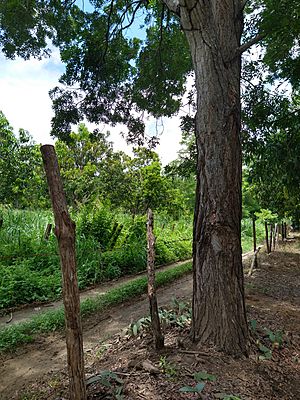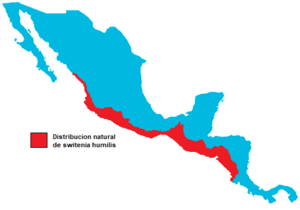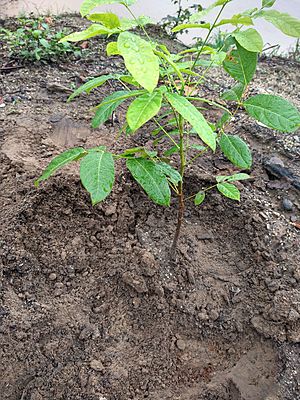Swietenia humilis facts for kids
Quick facts for kids Swietenia humilis |
|
|---|---|
 |
|
| S. humilis in San Luis de la Loma, Guerrero | |
| Conservation status | |
| Scientific classification | |
| Genus: |
Swietenia
|
| Species: |
humilis
|
 |
|
| Distribution in red | |
Swietenia humilis is a type of tree in the Meliaceae plant family. It is one of three kinds of trees in the Swietenia group. All three are known as "real mahogany" trees. This tree is much smaller than its relatives. It grows to about 6 meters (20 feet) tall. This is much shorter than S. mahagoni (five times taller) and S. macrophylla (six times taller). Its scientific name, humilis, means "small" or "dwarfish."
People call this tree by many names. Some common names are Pacific Coast mahogany and Mexican mahogany. In the wood business, it is also known as Honduras mahogany. Other names include caoba del Pacifico, caoba del Honduras, caobilla, cobano, gateado, sopilocuahuilt, venadillo and zapaton.
This tree has been cut down too much for its wood. Its wood is very valuable for making furniture. Scientists are also interested in the tree's seeds. They might be a source of useful oil or special chemicals.
Contents
Where the Pacific Coast Mahogany Lives
This tree grows in drier areas of the western Sierra Madre mountains. You can find it from Mexico all the way through Guatemala, Belize, Honduras, and El Salvador. In Guatemala and Honduras, it spreads from the Pacific Coast almost to the Atlantic Ocean. In Honduras, it also reaches into northern Nicaragua. The northern part of Costa Rica's Pacific Coast also has S. humilis trees.
These trees can grow at heights up to 1,200 meters (about 3,900 feet). They live in both wet and dry forests where trees lose their leaves. They also grow in savannas, rough scrublands, rocky hillsides, and even in farm fields. Because too many trees have been cut, the ones that are left are usually spread out. It is rare to find very large S. humilis trees now.
Protecting This Endangered Tree
The Swietenia humilis tree has special protection around the world. It is listed in Appendix II of CITES. CITES stands for the Convention on International Trade in Endangered Species of Wild Fauna and Flora. This is an agreement between countries. It helps control the trade of plants and animals that are at risk. This means that most parts of the tree cannot be traded easily.
The tree is also on the IUCN Red List of Threatened Species. It is listed as "Vulnerable." This means it is at high risk of becoming extinct (disappearing forever) in the wild.
Special Chemicals in the Tree
The Swietenia humilis tree contains some interesting chemicals.
Natural Defenses
The bark and seeds of the tree have a substance called an alkaloid. This substance can be harmful if eaten. It is known to stop the growth and feeding of some insects. For example, it works against mealworms and other pests like the European Corn borer. It also helps protect the tree from the Fall Armyworm.
Traditional Medicine Uses
People have used the seeds of S. humilis in traditional medicine. They use them to help with chest pains, coughs, and even some types of cancer. The seeds are also used to treat infections caused by amoebas and to get rid of worms. Scientists have been studying the seeds and bark since the 1990s to learn more about their medical uses.
Useful Seed Oil
Even though the seeds can be harmful, the tree might be a good source of oil. The oil from its seeds is similar to avocado and sunflower oils. About 45% of the seed's weight is edible oil. This oil contains different kinds of fats. About 18% are saturated fats, 30% are monounsaturated fats, and 48% are polyunsaturated fats. This oil could also be useful in making cosmetics and pesticides.
See also
 In Spanish: Caoba del Pacífico para niños
In Spanish: Caoba del Pacífico para niños





